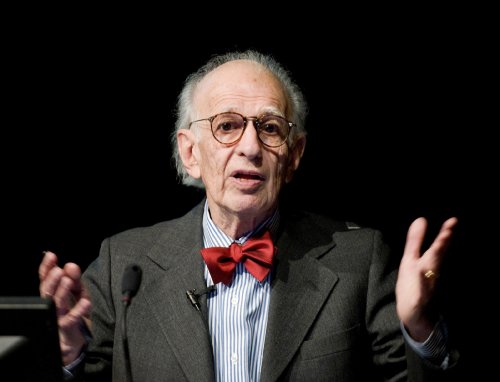
Nobel laureate Eric Kandel, M.D., outlined his research into human memory at the recent Earl W. Sutherland Lecture. (photo by Susan Urmy)
Nobel laureate shares trip down memory lane
At last week's Earl W. Sutherland Lecture, Nobel laureate Eric Kandel, M.D., took the overflow crowd on a whirlwind journey through his decades of memory research.
“Memory is the glue that binds our mental life together…it really makes us who we are,” said Kandel, professor of Biochemistry and Biophysics and director of the Kavli Institute for Brain Science at Columbia University in New York.
“I want to address one of the most remarkable problems of memory…how memory persists, how you remember your first love experience for the rest of your life.”
Kandel opted early in his career to study learning and memory in the sea slug Aplysia because of its simple nervous system and large nerve cells.
“Before I became presbyopic, I could see them with my naked eye,” he quipped.
His team studied a simple reflex behavior in Aplysia — the withdrawal of the gill when the animal is touched or shocked. After a single stimulus, the animal can remember and respond strongly to a subsequent stimulus for a few minutes. If the stimulus is repeated at least five times, the animal's memory will last for days.
Kandel and colleagues worked out the neural circuitry of the behavior and determined the molecular mechanisms that distinguish short-term from long-term memory. They found that to establish long-term memory, genes in the nerve cell nucleus must be activated to encode for proteins involved in the growth of new synaptic connections.
“It is the growth of synaptic connections that is the maintained form of long-term memory,” Kandel said.
Further studies suggested that there must be a mechanism for “marking” specific synapses for lasting memory formation, and the researchers implicated a protein called CPEB in this process.
They were surprised to find that the neuron-specific form of CPEB in Aplysia included a prion-like domain. Prions are self-perpetuating proteins associated with mad cow disease and variant Creutzfeldt-Jakob disease in humans.
The investigators now have strong evidence in Aplysia and fruit flies and “tantalizing” evidence in mice that a CPEB-like molecule, which is capable of self-perpetuation, is involved in the maintenance of synaptic growth — the cellular mechanism for long-term memory formation, Kandel said.
“This is the first time a prion mechanism has been described in which the protein in its aggregated, self-perpetuating form, is beneficial and serves a biological function,” he said.
“We're now looking for other 'functional prion' candidates; we think this mechanism could be used in a number of other contexts (in addition to maintenance of memory storage).”
The Department of Molecular Physiology and Biophysics established the lectureship in honor of Earl Sutherland, M.D., a former member of the department who was awarded the 1971 Nobel Prize in Physiology or Medicine for his discoveries related to cellular signaling and hormone action.













